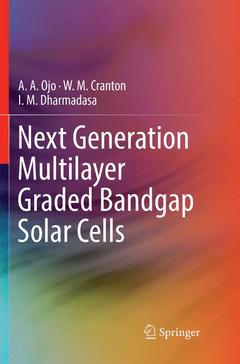Description
Next Generation Multilayer Graded Bandgap Solar Cells, Softcover reprint of the original 1st ed. 2019
Language: English
Publication date: 12-2018
Support: Print on demand
Publication date: 08-2018
Support: Print on demand
Description
/li>Contents
/li>Biography
/li>Comment
/li>
- Discusses in detail the processes of growths, treatments, solar cell device fabrication and solid state physics, improving readers? understanding of fundamental solid state physics;
- Enables future improvements in CdTe-based device efficiency;
- Explains the significance of defects in deposited semiconductor materials and interfaces that affect the material properties and resulting device performance.
Wayne Cranton is a Professor of Visual Technology at Sheffield Hallam University, and Assistant Dean, Research and Business Development for the Faculty of Arts, Computing, Engineering and Sciences. His research is concerned with the study of thin film materials for electronic devices, displays, sensors, and light emitting devices. This has involved a number of collaborative applied research and development programmes on the deposition and processing of light emitting materials, dielectrics, and metal oxide semiconductors, with recent emphasis on the localised photonic processing of materials for low temperature fabrication of flexible electronics and displays. Much of Wayne’s work builds from the development of techniques to fabricate and process materials for electroluminescent displays, optimising electro-optical functionality through deposition and laser processing. As a founding partner of the DisplayMasters Inter-University Programme in the UK, Wayne was part of the team that brought together display experts and students from around the globe, and whi
These books may interest you

Advances in thin-film solar cells 142.04 €

Advances in Thin-Film Solar Cells 143.25 €

Fundamentals of Solar Cell Design 220.32 €

